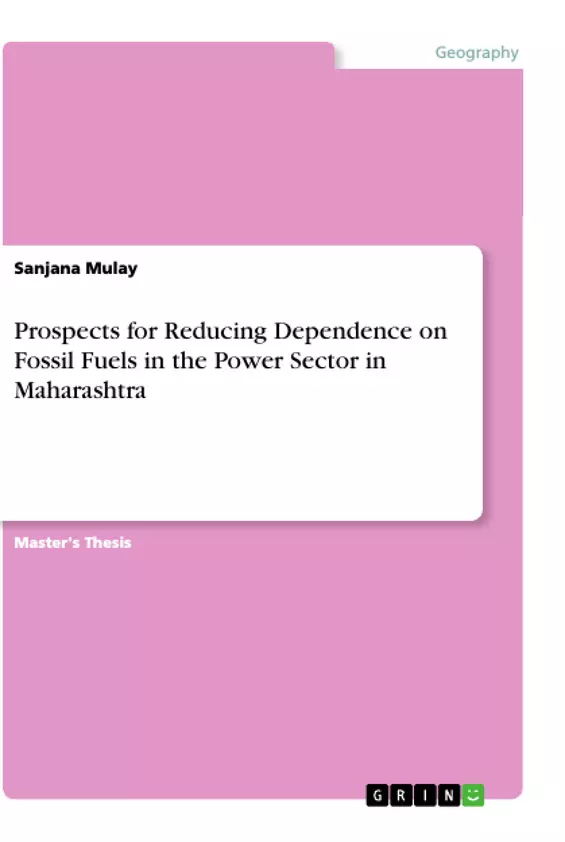The demand for electricity in Maharashtra will grow by 57% in the next ten years, from 142,848 MU in 2015 to 223,595 MU in 2025, according to calculations made in this dissertation that take the population growth rate and the State Domestic Product (SDP) growth rate into account. This translates to an increase of 80,746 MU. Dependence on fossil fuels to provide this amount of electricity is an unviable option from both the environmental as well as the economic point of view. The future of Maharashtra thus depends on replacing all fossil fuel-based energy with renewable energy. This dissertation aims to assess the extent to which fossil fuel- based energy can be replaced by renewable energy in 10 years’ time i.e. by 2025.
By 2025, the electricity requirement of Maharashtra will be 223,595 MU. As per the energy generation addition policies of the state government, a total of 247,066 MU of electricity from fossil fuels, nuclear energy and renewable energy sources will be available in the state as of 2025 (Government of Maharashtra, 2015). If the planned generation addition in coal (8.1 GW) were not to be taken into account, a total of 198,461 MU of electrical energy would be available to the state. There would thus be a deficit of 48,605 MU, which can be replaced with renewable energy.
With regard to price and value analysis, environmental pollution caused, installation time period and lifetime of the equipment and climatic conditions prevailing in Maharashtra, solar energy and onshore wind energy seem to be the most viable options to plug the supply deficit of 48,605 MU that would arise in the state by 2025. In one scenario, 70% (34,024 MU) of 48,605 MUcan be provided by solar energy and 30% (14,582 MU) can be provided by wind energy. In the second scenario, 60% (29,163 MU) can be provided by solar energy and 40% (19,442 MU) can be provided by wind energy. The replacement of 8.1 GW of coal-thermal capacity with renewable energy could potentially result in the avoidance of 40,500 premature deaths and emissions of 41 million tonnes of carbon dioxide per year. It would also lead to income generation of Rs. 1,266 crores to Rs. 1,486.5 crores for the general public due to the creation of new jobs in the renewable energy sector.
Inhaltsverzeichnis (Table of Contents)
- INTRODUCTION
- LITERATURE REVIEW
- RESEARCH METHODOLOGY AND OBJECTIVES
- OVERVIEW OF THE ENERGY SCENARIO IN MAHARASHTRA
- THE RENEWABLE ENERGY SCENARIO IN MAHARASHTRA
- RENEWABLE ENERGY POTENTIAL IN MAHARASHTRA
- COMPARISON OF RENEWABLE ENERGY SOURCES AND TECHNOLOGIES
- PATHWAY TO THE CREATION OF A FOSSIL FUEL-INDEPENDENT POWER SECTOR IN MAHARASHTRA
Zielsetzung und Themenschwerpunkte (Objectives and Key Themes)
This dissertation explores the feasibility of reducing Maharashtra's dependence on fossil fuels in the power sector, aiming to assess the potential for replacing fossil fuels with renewable energy sources by 2025. The study takes into account the projected increase in electricity demand, existing energy generation policies, and the economic and environmental implications of different energy options.
- Assessment of the electricity demand growth in Maharashtra.
- Evaluation of renewable energy potential in Maharashtra.
- Comparison of different renewable energy sources and technologies.
- Analysis of the economic and environmental implications of transitioning to a fossil fuel-independent power sector.
- Proposing a pathway for achieving a fossil fuel-free power sector in Maharashtra by 2025.
Zusammenfassung der Kapitel (Chapter Summaries)
- Introduction: Provides an overview of the research topic, outlining the problem of fossil fuel dependence in the power sector and the need for transitioning to renewable energy sources. It also introduces the context of Maharashtra's energy situation and the objectives of the dissertation.
- Literature Review: Examines existing literature on renewable energy, fossil fuel dependence, and energy policy, focusing on relevant studies and perspectives related to the Indian context and Maharashtra in particular.
- Research Methodology and Objectives: Describes the research methodology employed in the dissertation, including the data sources, analytical techniques, and key objectives of the study.
- Overview of the Energy Scenario in Maharashtra: Provides an in-depth analysis of Maharashtra's current energy scenario, examining the state's electricity demand, generation mix, and energy consumption patterns. It also discusses the challenges and opportunities related to the state's energy system.
- The Renewable Energy Scenario in Maharashtra: Focuses on the current state of renewable energy development in Maharashtra, analyzing existing policies, incentives, and the performance of various renewable energy projects. It also discusses the potential for further growth in the renewable energy sector.
- Renewable Energy Potential in Maharashtra: Explores the potential of different renewable energy sources, such as solar, wind, biomass, and geothermal, in meeting Maharashtra's growing electricity demand. It considers the technical feasibility, economic viability, and environmental implications of each source.
- Comparison of Renewable Energy Sources and Technologies: Compares and contrasts the various renewable energy technologies available, considering factors such as cost, efficiency, environmental impact, and suitability for Maharashtra's specific conditions. It aims to identify the most viable options for replacing fossil fuel-based energy.
- Pathway to the Creation of a Fossil Fuel-Independent Power Sector in Maharashtra: Presents a comprehensive plan for transitioning to a fossil fuel-free power sector in Maharashtra. It outlines the necessary steps, policy interventions, and investments required to achieve this goal.
Schlüsselwörter (Keywords)
Renewable energy, fossil fuels, power sector, Maharashtra, electricity demand, energy policies, solar energy, wind energy, environmental sustainability, economic feasibility, energy transition, pathway to decarbonization.
- Arbeit zitieren
- Sanjana Mulay (Autor:in), 2015, Prospects for Reducing Dependence on Fossil Fuels in the Power Sector in Maharashtra, München, GRIN Verlag, https://www.grin.com/document/985737



